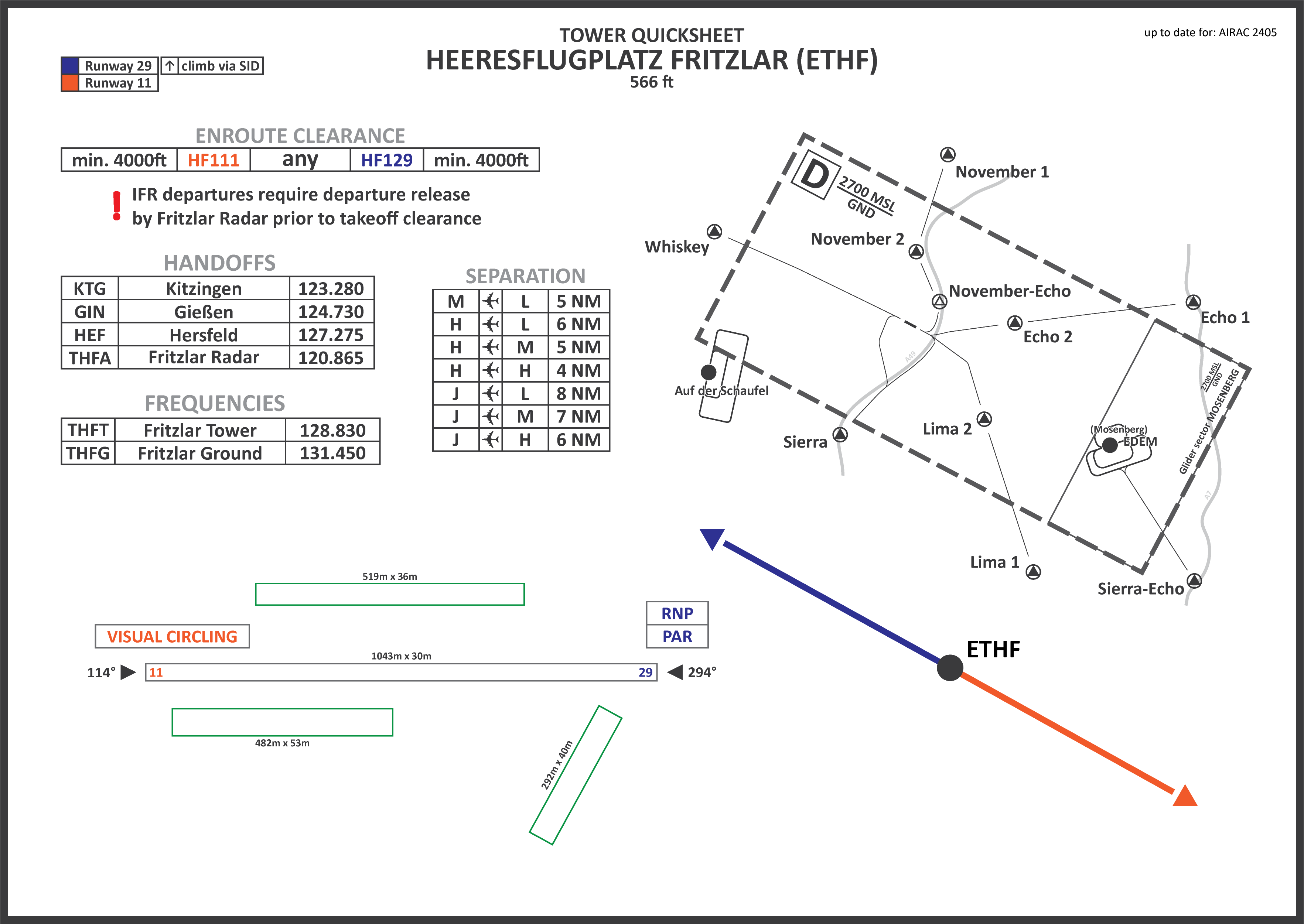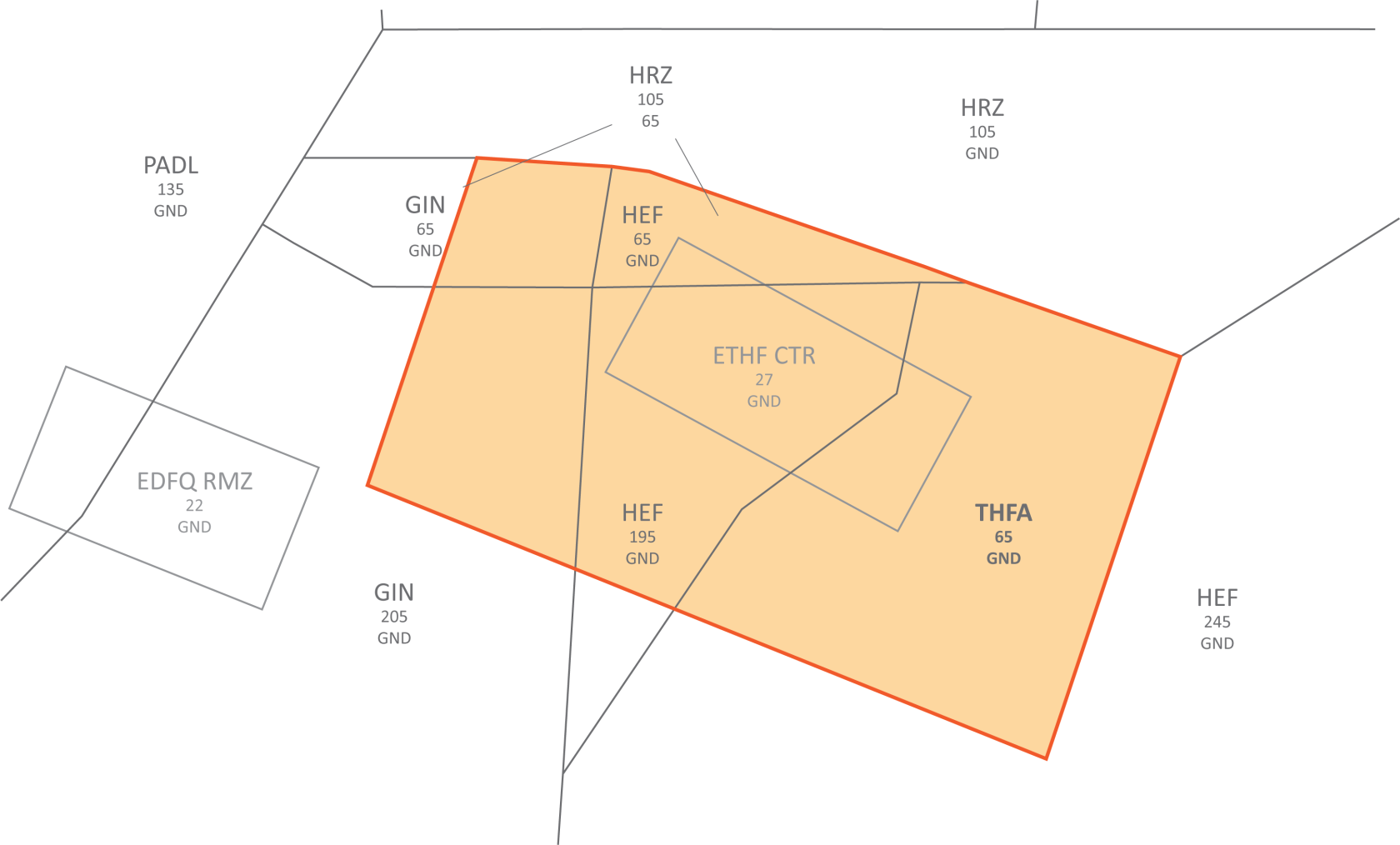# ETHF - Fritzlar Airbase
# Overview
Fritzlar is a Bundeswehr base in Fritzlar. Originally a Luftwaffe base during World War II, after the end of the war it was first under American and then under French control before being returned to the German military in 1956. It primarily hosts helicopters from Transporthubschrauberregiment 10, Transporthubschrauberregiment 30, and Kampfhubschrauberregiment 36, but its 1043m hard surface runway can also support smaller fixed wing aircraft. Additionally, an army ambulance regiment is stationed at the airport which attracts medevac and other medical flights as well.
As Fritzlar is a military airport, charts can't be found in the normal AIP. They are accessible through the MIL AIP, GEMIL FLIP VAD, and CENOR FLIP in the [milais](https://www.milais.org/publications.php "MILAIS Publications").
**Fritzlar is an unrestricted airport**. The Ground position can be staffed by all controllers with an **S1** rating or higher. The Tower position can be staffed by all controllers with an **S2** rating or higher. The radar position can be staffed by all controllers with an **S3** rating or higher. However, controllers should closely familiarize themselves with military procedures before staffing the airport.
### Fritzlar ATC Stations
| **Station**
| **Station ID**
| **Login**
| **Frequency**
| **Remarks**
| **Endorsement**
|
| **Ground**
| THFG
| ETHF\_GND
| 131.450
| fictional frequency, military station
| unrestricted: no course
|
| **Tower**
| THFT
| ETHF\_TWR
| 128.830
| fictional frequency, military station
| unrestricted: no course |
| **Arrival**
| THFA
| ETHF\_APP
| 120.865
| military station
| unrestricted: no course |
### Quickview
[](https://dms.vatsim-germany.org/s/fdy6CgpsaEG5XZE "ETHF Quicksheet (VATGER DMS)")
*click on the image to open the printable quicksheet*
# Ground
Fritzlar Ground is responsible for all enroute and startup clearances as well as ground movements at the airport.
### Enroute clearances
All enroute clearances must be **coordinated with Fritzlar Radar**. The clearance will be given by Fritzlar Radar to be **relayed to the pilot** by Fritzlar Ground. Usually, pilots are first given their startup and taxi clearance and the enroute clearance is coordinated while the aircraft is on its way to the runway to be **given at the holding point shortly before departure**. If Fritzlar Radar is offline, the enroute clearance has to be coordinated with the appropriate civilian radar controller.
Further information on clearances to be given can be found in the [ETHF Approach SOP](https://knowledgebase.vatsim-germany.org/books/sops-fir-langen/page/approach-EY2 "ETHF Approach SOP").
### Startup
All IFR and VFR aircraft at Fritzlar require a startup clearance from Fritzlar Ground.
# Tower
Fritzlar Tower is responsible for all traffic on the runway, helipad, and grass lanes as well as traffic within the CTR of the airport.
### General
##### Operating direction
As only runway 30 has instrument approaches, it is the preferred runway whenever conditions permit.
##### Runway crossing
Runway crossings are principally the responsibility of Fritzlar Tower. However, after coordination, aircraft may remain on the Ground frequency for their runway crossing.
##### Grass lanes
The grass lanes (as well as the helipad) may all be **used in parallel** to the hard surface runway and other grass lanes. They are generally only used for helicopter traffic.
### Non-line taxi
After coordination with Fritzlar Ground, helicopters may be cleared directly to the departure runway or parking position without using the taxiways. This non-line taxi **shall always take place on the Tower frequency**, thus outbound non-line taxi has to be handed over from Ground to Tower for the taxi clearance. Non-line taxi is **not available for fixed wing aircraft**.
> **Fritzlar Tower**: Colibri 36, air-taxi direct to holding point runway 30.
### IFR traffic
All IFR traffic shall use the hard surface runway. The grass lanes and the helipad are only available for VFR traffic.
##### Departures
A **departure release for all IFR departures** shall be obtained from Fritzlar Radar.
Departures shall be handed off to Fritzlar Radar as soon as possible.
##### Arrivals
As only runway 30 has instrument procedures, a **circling approach South of the airport is required for all IFR inbounds during 12 operations**.
During activity of the Mosenberg sector, **IFR arrivals will enter this sector during their descent**. In this situation, the IFR arrival shall be informed about possible VFR traffic in the vicinity of Mosenberg and Fritzlar Tower shall inform Mosenberg Radio of all IFR inbounds. If VFR traffic within the Mosenberg traffic circuits complies with the circuit altitude of 2000ft AMSL and IFR inbounds don't descend below the normal glide profile, **no conflicts should arise**.
For IFR arrivals on a PAR approach, a landing clearance shall be relayed to Fritzlar Radar. Depending on the traffic situation, **Tower may instruct Fritzlar Radar to hand these arrivals directly off to Ground**.
### VFR traffic
##### Noise abatement
Traffic should avoid overflying the town of Fritzlar directly North of the airfield below 2000ft. Due to this, the **Southern traffic circuit shall be used whenever possible**.
##### Reporting points
There are ten reporting points around the Fritzlar CTR, all of which except for November Echo are mandatory reporting points. Additionally, reporting point **Sierra Echo is only used for traffic approaching or departing Mosenberg (EDEM)** and should generally be the entry/exit point for traffic at this airfield.
| **Reporting point**
| **Location**
| **Remark**
|
| **Echo 1**
| A7/B253 intersection
| --
|
| **Echo 2**
| B254 exit between town of Wabern and fresh concrete quarry Wabern
| --
|
| **Lima 1**
| Lützelwig village
| --
|
| **Lima 2**
| railroad crossing South of Uttershausen
| --
|
| **November 1**
| Gleichen village
| --
|
| **November 2**
| A49/L3150 intersection
| --
|
| **November Echo**
| A49 Eder bridge
| non-compulsory reporting point
|
| **Sierra**
| A49/B3 intersection
| --
|
| **Sierra Echo**
| A7/B323 intersection
| reporting point for EDEM only |
| **Whiskey**
| Anraff village
| --
|
##### Mosenberg (EDEM)
Mosenberg's runway and traffic circuits are located within the Fritzlar CTR. Pilots flying at Mosenberg require an individual clearance to enter the CTR and operate at the airfield. If Mosenberg Radio is staffed, the **radio operator may request the Mosenberg sector to be opened** in which case this part of the Fritzlar CTR reverts to airspace class G and E, respectively, and pilots are allowed to operate inside this sector without acquiring an individual clearance to enter the Lahr CTR. However, **inbound aircraft are still required to make the initial call to Fritzlar Tower** even when the Mosenberg sector is active and shall be handed off to Mosenberg Radio as soon as possible; vice versa, Mosenberg Radio is required to inform Fritzlar Tower about any outbound aircraft. During high traffic operations at Fritzlar, it is recommended not to open the Mosenberg sector and if necessary prevent traffic at the airfield entirely. Aircraft departing from or arriving at Mosenberg should always **route via reporting point Sierra Echo**.
##### Auf der Schaufel
Auf der Schaufel is an airfield for ultralight aircraft. It's traffic circuit extends into the Fritzlar CTR. **Pilots flying at Auf der Schaufel require an individual clearance to enter the CTR**. There is no separate sector that can be opened and due to a lack of an ICAO code for the airfield, Auf der Schaufel Radio cannot be staffed on VATSIM.
# Approach
Fritzlar Radar is responsible for all airborne traffic within the Fritzlar approach sector as well as coordinating all enroute clearances for IFR departures out of Fritzlar airport.
Fritzlar Radar shall **always inform the controllers of EDGG sectors Hersfeld and Gießen as well as the controller of EDWW sector Harz** when opening and closing the position.
### Airspace
The airspace controlled by Fritzlar Radar is class E which is lowered to 1000ft AGL in the entire area of responsibility.
[](https://knowledgebase.vatsim-germany.org/uploads/images/gallery/2024-04/ethf.png)
### Departure procedures
##### Enroute clearances
Enroute clearances must **always be coordinated with all concerned adjacent sectors**. Exact routings to the first fix in the flight plan must be adapted to the individual traffic situation but **usually a DCT to the first waypoint is the best solution**. The initial climb shall always be at least 4000ft and should not exceed FL60. Higher initial flight levels must be coordinated with all concerned sectors. All IFR departures shall use the applicable OID for the departure runway.
The enroute clearance will be requested by Fritzlar Ground and has to be communicated to Fritzlar Ground once it has been coordinated. Fritzlar Ground will then relay the clearance to the pilot.
##### Transfer to civilian ATC
Handoffs for departures shall always be **coordinated individually** (preferably while coordinating the enroute clearance) and then take place as agreed.
### Arrival procedures
##### Transfer from civilian ATC
Handoffs for arrivals shall always be **coordinated individually** and then take place as agreed. Fritzlar Radar should, whenever possible, approach civilian ATC with a proposal for the handoff ahead of time, but **usually a DCT to the respective IAF** (from the South: RANIN, from the North: KEMAD) **at 5000ft with a full release is the best solution**.
##### Approach
Fritzlar only has instrument approach procedures for runway 30. Thus, a **circling approach is required during 12 operations**.
The **RNP approach should be used primarily**; however, there is also a PAR approach available.
Since **Fritzlar Precision is currently not implemented on VATSIM**, PAR approaches can only be conducted if traffic levels permit - if necessary, Fritzlar Radar can coordinate with civilian ATC to keep other inbound traffic outside of the airspace while a PAR approach is taking place; whether this is possible, however, depends on the current workload of civilian ATC.